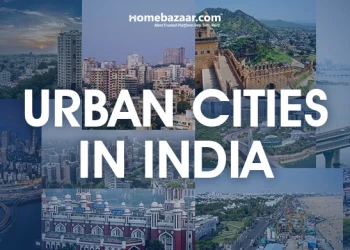1-minute brief summary: Is Pune A Metro City?
Pune is not officially recognised as a metro city by the government due to its tax exemptions. However, it is one of the top metropolitan cities in India. It is recognised for its progressive commercialisation, ambitious infrastructure, and diverse housing options. Education and cultural aspects of Pune give it a distinctive identity.
The IT infrastructure in Pune has been driving its growth over the last decade. The city has earned a reputation as the Oxford of the East while hosting some prestigious educational landmarks in the country. Along with these, Pune is home to many historical landmarks and tourist attractions.
Pune is an ideal alternative to Mumbai in terms of housing, rent, education, cost of living, environmental factors, and employment opportunities. Owing to its booming IT infrastructure and industrial sector, Pune holds huge investment potential. Emerging residential destinations have upgraded the scope of premium housing at a relatively low cost.
Considering these factors, Pune is a major metropolitan city in India and assures lucrative returns on investment.
Also read: Metropolitan Cities in India 2025
Page Contents [hide]
How Is The Economic Growth In The Pune Metropolitan Area?

Pune is among the booming metropolitan cities in India with progressive commerce and economic growth. The city is home to numerous manufacturing units, FMCGs, pharmaceuticals, IT companies, and financial services. Automotive, manufacturing, IT, and education are the growth-stimulating industries in Pune. The current GDDP of Pune is around ₹ 2,81,986 crores as stated in the Economic Survey of Maharashtra of 2024-25.
Some of the prominent industrial hubs in Pune are Chakan, Pimpri, Talegaon, Baramati, Indapur, Ranjangaon, etc. Moreover, special economic zones (SEZs) like Rajiv Gandhi Infotech Park, Khed Special Economic Zone, and Serum Bio-Pharma Park are driving the employment generation in the city. Also, a logistics park is proposed at Pune, as per the Pune District Profile report by the Maharashtra Government.
Pune has a significant number of Global Capacity Centres (GCCs), which are accelerating the economic growth in the city. The Aundh, Viman Nagar, Kharadi, Hinjewadi, Wagholi, and Baner-Balewadi belt are the major IT centres in Pune that are attracting foreign investments.
How Better Is The Infrastructure In Pune Metropolitan Area?

The Pune metropolitan area has a well-established infrastructure. It comprises some of the well-known educational institutions, such as Savitribai Phule University, Fergusson College, Symbiosis Institute, Bharati Vidyapeeth, etc. It also offers sound recreation, healthcare, and entertainment facilities.
BRT and PMPL buses have a good frequency during peak office timings. The operational and upcoming metro lines have uplifting the connectivity system of the city. The railway network enables seamless commuting. Pune International Airport is strategically located and accessible from other part of the city.
Also read: Infrastructure Projects in Pune
How Is The Real Estate Scenario In The Pune Metropolitan Area?

Pune real estate has witnessed a stupendous growth over the last few years. The city has witnessed a price appreciation of 12% in 2024. With relatively affordable housing than in Mumbai and Bangalore, Pune is the preferred destination among modern homebuyers. Pune residential market is shifting towards premium and luxury properties.
With increasing disposable income and aspiration for more space, homebuyers are opting for luxury and ultra-luxury housing. The mid-range properties dominate the Pune residential market, while affordable housing experiences a decline in its demand.
The demand for residential and commercial properties in Pune is backed by its infrastructure, IT corridor, and reasonable prices than other markets in the country. Due to its active workplaces, the average rental income in Pune is between 7% – 8%.
Considering real estate, below is the Pune city area name list:
| Area | Average Property Price (per sq. ft.) |
| Hinjewadi | ₹ 7,800 per sq. ft. |
| Baner | ₹ 10,800 per sq. ft. |
| Kharadi | ₹ 10,410 per sq. ft. |
| Aundh | ₹ 10,810 per sq. ft. |
| Kalyani Nagar | ₹ 14,000 per sq. ft. |
| Magarpatta | ₹ 12,800 per sq. ft. |
Also read: Pune Real Estate Overview
What Is The Cost Of Living In The Pune Metropolitan Area?

The cost of living is moderate. The housing prices are less compared to Mumbai. One can get a spacious 2 BHK apartment in Pune within ₹ 1 Crore, which is not feasible in cities like Mumbai and Bangalore. The cost of living in Pune is based on individual’s property type, location, neighbourhood, utilities, and lifestyle preferences.
The average cost of an apartment in Pune could range from ₹ 10,000 per sq. ft. to 22,000 per sq. ft. This cost is based on the project type, location, and facilities offered. The average of a 1 BHK apartment in Pune can range around ₹ 7,000. Apart from this, household, transportation, utility, and other expenses in Pune are cheaper.
Is Pune expensive to live in?
Yes, Pune might be expensive or affordable to many depending on their property location, lifestyle preferences, and income level. However, it is generally cheaper than major cities like Mumbai, Delhi NCR, and Bangalore.
Is Pune a Tier 1 city?
Yes, Pune is a Tier 1 city considering its infrastructure, economic development, and business growth.
Which are the best places to visit in Pune?
The best places to visit in Pune are Shrimant Dagdushet Mandir, Shaniwar Wada, Sinhagad Fort, Shivneri Fort, Aga Khan Palace, Saras Baug, etc.
Also read: Pune vs Bangalore – Cost of Living








